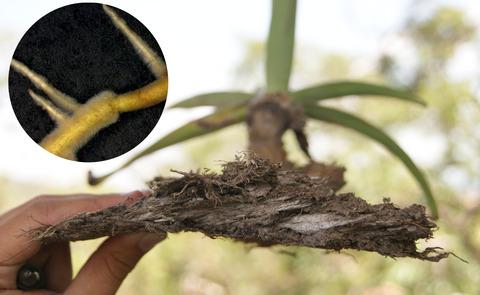当前位置:
X-MOL 学术
›
Funct. Ecol.
›
论文详情
Our official English website, www.x-mol.net, welcomes your
feedback! (Note: you will need to create a separate account there.)
Vellozioid roots allow for habitat specialisation among rock‐ and soil‐dwelling Velloziaceae in campos rupestres
Functional Ecology ( IF 4.6 ) Pub Date : 2019-12-14 , DOI: 10.1111/1365-2435.13479 Anna Abrahão 1, 2, 3 , Patricia de Britto Costa 1, 2 , Grazielle S. Teodoro 4 , Hans Lambers 2 , Diego L. Nascimento 5 , Sara Adrián López de Andrade 1 , Megan H. Ryan 6 , Rafael Silva Oliveira 1, 2
Functional Ecology ( IF 4.6 ) Pub Date : 2019-12-14 , DOI: 10.1111/1365-2435.13479 Anna Abrahão 1, 2, 3 , Patricia de Britto Costa 1, 2 , Grazielle S. Teodoro 4 , Hans Lambers 2 , Diego L. Nascimento 5 , Sara Adrián López de Andrade 1 , Megan H. Ryan 6 , Rafael Silva Oliveira 1, 2
Affiliation

|
Plant growth on harsh substrates (habitat specialization) requires specific traits to cope with stressful conditions. We tested whether traits related to nutrient acquisition (root colonization by fungal symbionts, and plant morphological and physiological specializations), and nutrient use (leaf nitrogen (N) and phosphorus (P) concentrations and N‐ and P‐remobilization efficiency), were related to habitat specialization for 27 species of Velloziaceae growing either in soil or on rocks in extremely P‐impoverished campos rupestres habitats. If habitat specialization were to drive trait sorting, then we expect traits to differ between those substrates. Both soil and rock‐dwelling species presented a very low proportion of root length colonized by arbuscular mycorrhizal and dark‐septate fungi. However, rhizosheaths were only observed in soil‐dwelling species, and vellozioid roots, a specialization that allows for mining P and dissolving quartzite rock, were mostly found in rock‐dwelling species. We did not observe differences in nutrient‐use traits between rock‐ and soil‐dwelling species. Root specializations are strongly correlated with microhabitats, and the presence of vellozioid roots seems to mediate bare rock specialization. There is an overall P limitation of plant productivity both on rock and in soil of campos rupestres, which does not drive the sorting of traits related to above‐ground nutrient use and symbiotic P acquisition. Therefore, nutrient impoverishment is indeed a very strong environmental filter in campos rupestres as a whole, but habitat specialization plays an important role in the spatial distribution of Velloziaceae between contrasting substrates.
中文翻译:

Vellozioid 根允许在 Campos rupestres 中栖息在岩石和土壤中的 Velloziaceae 中的栖息地专业化
在恶劣的基质上生长(栖息地专业化)需要特定的特性来应对压力条件。我们测试了与养分获取(真菌共生体的根系定植、植物形态和生理特化)和养分利用(叶氮 (N) 和磷 (P) 浓度以及 N 和 P 再动员效率)相关的性状是否相关对生长在土壤或岩石上的 27 种 Velloziaceae 物种进行栖息地专业化,这些物种在极度贫瘠的 Campos rupestres 栖息地中生长。如果栖息地专业化会推动性状分类,那么我们预计这些基质之间的性状会有所不同。土壤和岩栖物种的根长比例非常低,被丛枝菌根和暗隔膜真菌定殖。然而,根鞘仅在土栖物种中观察到,而vellozioid 根,一种允许开采磷和溶解石英岩的特化,主要存在于岩栖物种中。我们没有观察到岩栖物种和土栖物种之间养分利用特性的差异。根系特化与微生境密切相关,并且丝状根的存在似乎介导了裸岩特化。Campos rupestres 的岩石和土壤中的植物生产力存在总体磷限制,这不会推动与地上养分利用和共生磷获取相关的性状分类。因此,营养贫乏确实是整个campos rupestres的一个非常强大的环境过滤器,
更新日期:2019-12-14
中文翻译:

Vellozioid 根允许在 Campos rupestres 中栖息在岩石和土壤中的 Velloziaceae 中的栖息地专业化
在恶劣的基质上生长(栖息地专业化)需要特定的特性来应对压力条件。我们测试了与养分获取(真菌共生体的根系定植、植物形态和生理特化)和养分利用(叶氮 (N) 和磷 (P) 浓度以及 N 和 P 再动员效率)相关的性状是否相关对生长在土壤或岩石上的 27 种 Velloziaceae 物种进行栖息地专业化,这些物种在极度贫瘠的 Campos rupestres 栖息地中生长。如果栖息地专业化会推动性状分类,那么我们预计这些基质之间的性状会有所不同。土壤和岩栖物种的根长比例非常低,被丛枝菌根和暗隔膜真菌定殖。然而,根鞘仅在土栖物种中观察到,而vellozioid 根,一种允许开采磷和溶解石英岩的特化,主要存在于岩栖物种中。我们没有观察到岩栖物种和土栖物种之间养分利用特性的差异。根系特化与微生境密切相关,并且丝状根的存在似乎介导了裸岩特化。Campos rupestres 的岩石和土壤中的植物生产力存在总体磷限制,这不会推动与地上养分利用和共生磷获取相关的性状分类。因此,营养贫乏确实是整个campos rupestres的一个非常强大的环境过滤器,











































 京公网安备 11010802027423号
京公网安备 11010802027423号